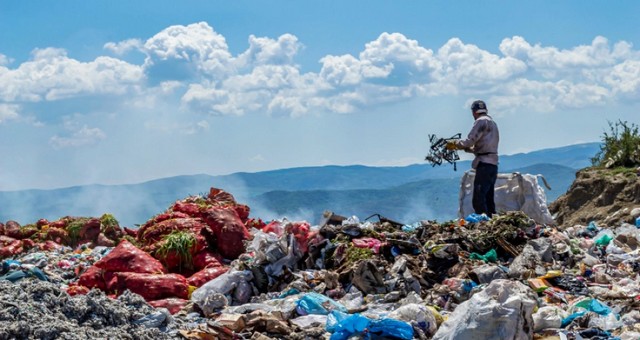A circular economy (CE) is a systemic approach to economic development designed to benefit businesses, society, and the environment. Unlike the traditional linear economy, which follows a ‘take, make, dispose’ model, the circular economy focuses on minimising waste and reusing resources. At its core, CE emphasises reducing resource input and waste generation through reuse, recycling, and recovery.
Therefore, a Solid Waste Management (SWM) strategy is integral to achieving a circular economy. Proper SWM ensures that materials are kept in use for as long as possible and helps to close resource loops. However, waste management remains a global challenge, especially with growing waste generation and inadequate systems in many regions.
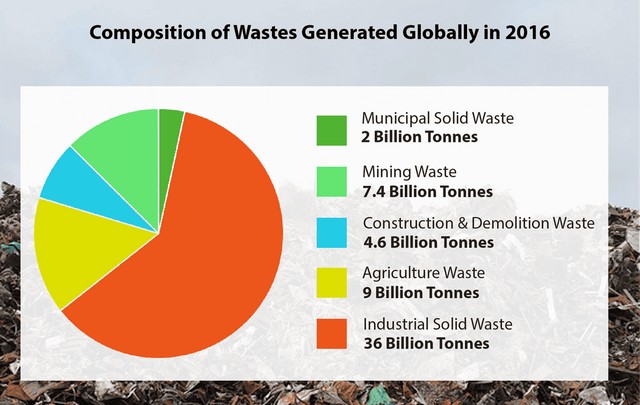
Why Does a Proper SWM Matter?
A successful SWM system is a vital component of good governance. Effective waste management reduces adverse health and environmental impacts, conserves resources, and improves urban liveability. Furthermore, SWM plays an essential role in achieving sustainable development, as emphasised in several international development agendas and charters. For example, a sustainable SWM system can contribute to achieving the United Nations’ Sustainable Development Goals (SDGs), such as:
- SDG6: Clean Water and Sanitation
- SDG11: Sustainable Cities and Inclusive Communities
- SDG12: Responsible Consumption and Production
- SDG13: Climate Action
- SDG15: Life on Land
Solid waste management, particularly when aligned with circular economy principles, fosters a more sustainable, resource-efficient urban economy. It encourages a reduction in the consumption of finite resources and promotes the reuse and recycling of materials, ultimately helping to eliminate waste, reduce pollution, save costs, and stimulate green growth.
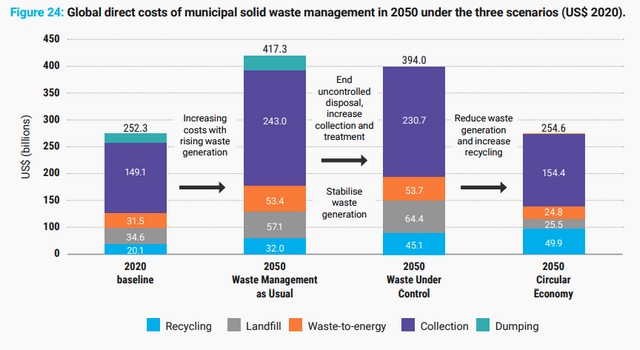
Despite the urgent need for effective SWM, global waste generation continues to rise, driven by economic growth, improved lifestyles, and increased consumerism. According to the United Nations Environment Programme, an estimated 11.2 billion tonnes of solid waste are collected worldwide each year, with the decay of organic waste contributing approximately 5% of global greenhouse gas emissions. E-waste, in particular, presents a rapidly growing challenge, as it contains hazardous substances that can have severe environmental consequences.
While city administrators are tasked with managing municipal solid waste, the problem extends beyond urban waste. Several waste streams—such as agricultural waste, construction and demolition debris, and industrial solid waste—often go unrecorded but can be much larger than municipal waste. Globally, industrial solid waste is 18 times greater than municipal solid waste, and agricultural waste is 4.5 times greater.
Towards a Circular Economy: Waste Management’s Role
The concept of a Circular Economy has emerged as a vital solution to waste management challenges. Rather than following the traditional linear economy model, where resources are extracted, used, and discarded, the circular economy seeks to keep materials in use for as long as possible through reuse, recycling, and remanufacturing.
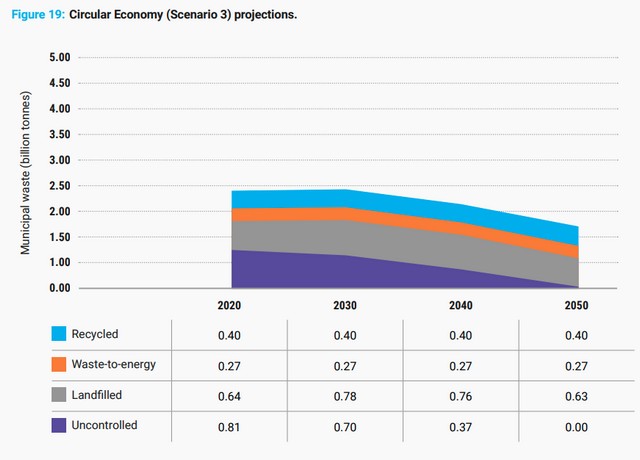
Adopting a circular economy approach could significantly reduce the global waste burden. According to the Global Waste Management Outlook 2024, if the world embraces circular economy practices by 2050, the volume of municipal solid waste could be reduced from over 4.5 billion tonnes annually to less than 2 billion tonnes. The report also estimates that this approach could eliminate uncontrolled waste disposal and cut landfill waste by more than 40%.
Financially, transitioning to a circular economy could save billions in waste management costs. Continuing with current practices could cost the world $417 billion a year by 2050, a sharp rise from $252 billion in 2020. In contrast, adopting circular economy practices—such as waste reduction and increased recycling—could cap costs at under $255 billion per year.
By minimising waste and maximising resource efficiency, the circular economy also addresses broader environmental concerns. The mismanagement of organic waste, for instance, contributes significantly to methane emissions, a potent greenhouse gas. Methane emissions from solid waste are expected to rise by 13 million tonnes annually over the next decade. Moreover, the disposal of plastic waste, which can leak into ecosystems, continues to have detrimental effects on biodiversity and marine life.
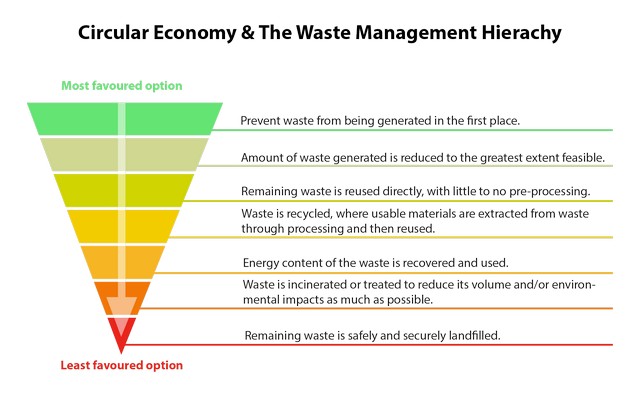
Challenges of the Linear Economy
The current Linear Economy model is unsustainable in light of the triple planetary crises of climate change, biodiversity loss, and pollution. The mismanagement of solid waste, especially organic and hazardous materials, is a significant contributor to global environmental degradation. Organic waste, particularly from food systems, is responsible for approximately 20% of methane emissions, while plastic waste pollution in aquatic ecosystems is expected to nearly triple by 2040 without intervention.
Plastic waste has devastating effects on marine ecosystems, causing both lethal and sub-lethal harm to countless species. The chemicals leaching from plastic also threaten human and marine health. Similarly, hazardous waste mismanagement contaminates soil and freshwater, exacerbating environmental damage.
As such, the role of SWM in achieving global sustainability goals cannot be overstated. As we look toward the future, aligning solid waste practices with circular economy principles becomes an opportunity for innovation, economic growth, and environmental stewardship.
The Ideal SWM Hierarchy To Drive A Circular Economy
The Global Alliance on Circular Economy and Resource Efficiency has conducted an extensive study on circular economy-based operational changes in various industries across the globe. Based on the analysis of the data collected, they have narrowed down the following legislation principles in the waste management hierarchy to build and sustain a circular economy:
1. Extraction, Processing, Manufacture, and Distribution:
- Resource Efficient and Cleaner Production (RECP):
- Essential for minimising solid waste during the early stages of product lifecycles, such as raw material extraction and manufacturing. RECP identifies waste and pollution generation points and offers feasible methods for reducing or recycling these outputs.
- Challenges: Many enterprises, especially MSMEs, are hesitant to adopt RECP due to limited access to capital, despite its potential to reduce costs and environmental impact. Government support in training and certification could increase adoption.
- Industrial Symbiosis: Encourages collaboration between enterprises where waste from one serves as raw material for another. Government-backed platforms could facilitate these exchanges.
- Design for Circularity: This approach ensures products are designed for reuse, recycling, or value recovery. Incentivising companies to adopt circular designs—such as using eco-friendly materials—can lead to a more sustainable supply chain.
2. Use and Consumption:
- Consumer Decisions:
- Reducing solid waste begins with consumers making conscious decisions, such as choosing not to buy certain products (“Refuse”) or opting for rental services, which leads to fewer products being circulated and ultimately discarded.
- Consumers can also choose durable, repairable, and second-hand products, thus extending product life and reducing waste.
- Government Role: Governments can support circular consumption by educating consumers, implementing public procurement strategies for circular products, and providing fiscal incentives for environmentally friendly products.
- Maintaining Products: Proper maintenance and repair further prolong the lifespan of products, reducing the rate of waste generation.
3. Remanufacturing, Refurbishing, Cascading, and Recycling:
- Remanufacturing and Refurbishing:
- By disassembling, repairing, and reassembling products, the useful lives of parts are extended, significantly reducing waste. Refurbishing offers a similar process but yields lower-quality outcomes compared to remanufacturing.
- Cascading: Involves reusing materials with minimal processing, which extends the useful life of resources without the need for extensive recycling processes.
- Recycling: When no other reuse or remanufacturing options exist, recycling converts materials back into raw inputs for new products. However, challenges arise with mixed-material waste, which increases processing costs. Source-separation of waste can streamline recycling, making it more efficient.
- Extended Producer Responsibility (EPR): Governments can introduce EPR policies where manufacturers take responsibility for the end-life management of their products, promoting closed-loop recycling.
4. Role of Innovation in Promoting Circular Practices:
- Innovation as a Key Driver: Circular solutions require innovative product designs, business models, and partnerships. Governments can support this through startup incubators, R&D programs, and low-interest loans.
- Government Policies: Existing policies could be adapted to prioritise circular solutions by encouraging innovation, facilitating collaborations (e.g., between businesses and academia), and offering fiscal incentives.
- Public Procurement and Standards: Governments can drive demand for circular products by setting procurement standards, supporting certification systems, and adjusting fiscal incentives to make circular alternatives more competitive than their linear counterparts.
By addressing these stages, governments, enterprises, and consumers can work together to transition toward a circular economy that minimises solid waste and reduces environmental impacts. Each article can focus on different aspects, such as the role of enterprises and government policies in reducing waste in manufacturing for one article, and consumer behaviour and recycling practices in the other.
To summarise, effective Solid Waste Management is critical for addressing the environmental and health crises facing urban areas today. Cities worldwide must transition from the linear economy to the Circular Economy, where resources are reused, waste is minimised, and sustainable practices are adopted. By investing in waste reduction, recycling, and energy recovery, city administrators can significantly reduce the environmental and economic impacts of waste, paving the way for a more sustainable and liveable future.
References
- “Britannica — Solid Waste Management”
- “United Nations Environment Programme — Solid Waste management”
- “Circular Economy and Solid Waste — United Nations Industrial Development Organisation (UNIDO)”
- “Global Waste Management Outlook 2024“
- “Municipal solid waste management in Malaysia: Practices and challenges, Waste Manag. 2009”
- “World Bank Solid Waste Management”
- “Solid Waste Management in Malaysia: An overview”
- “Municipal Solid Waste Management in the Sarawak State of Malaysia and the Way Forward”
- “Dr Sim: Waste collected by councils increasing every year”
- “Circular Economy Solid Waste Management — Kementerian Ekonomi”


